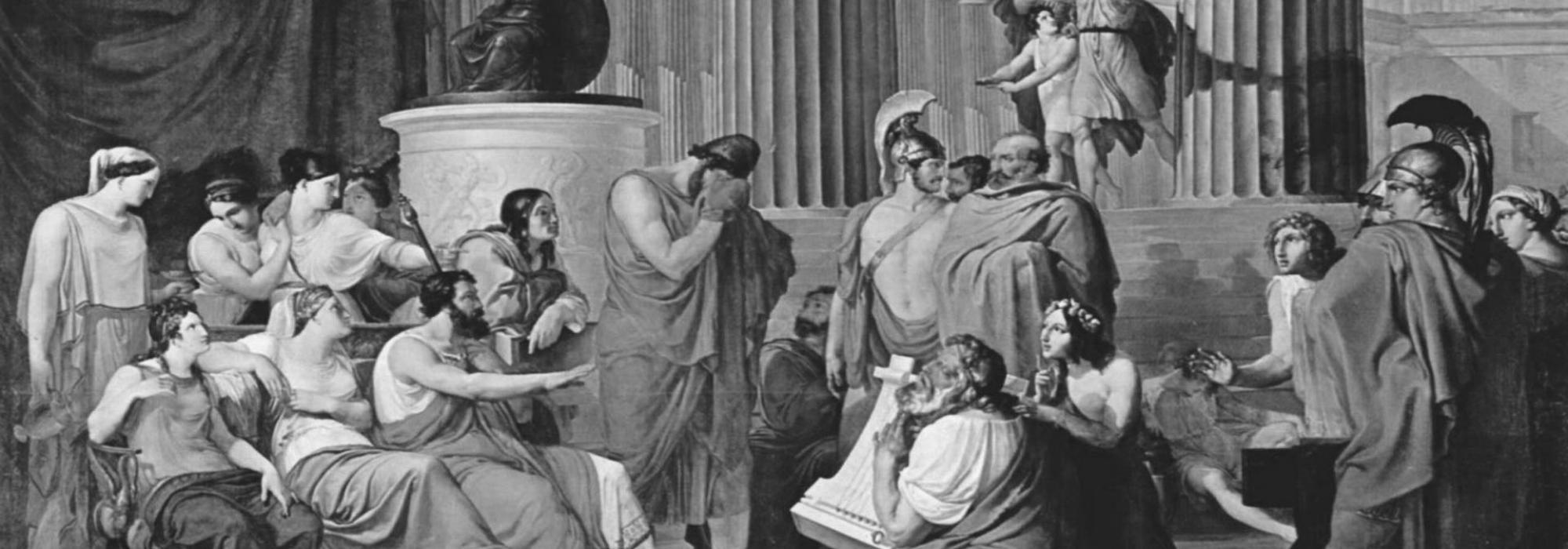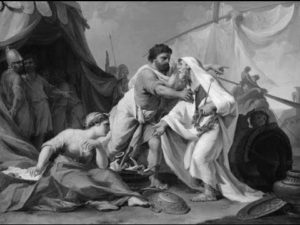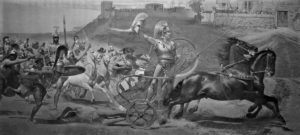The epics, Iliad and Odyssey of Homer, largely complement each other in terms of what they offer to connoisseurs. Using the terminology of the rasas (flavours of emotions), the predominant rasa in the Iliad, which also acts as the sthāyi-bhāva, is valour (vīra). To sustain the undercurrent of valour for over 15,000 lines is a great challenge, which has been met successfully only by poets like Vālmīki, Vyāsa and Homer. This indeed gives us the impression that Greek civilization is virile and masculine in its taste while the Indian is more feminine. (Whereas classical Sanskrit poetry mostly comprises stylized expression, adding to its feminine nature, Greek poetry is more direct, more straightforward). In addition to vīra, the associated emotions like raudra, bhībhatsa and bhayānaka, too, take prominence in the Iliad. There is a touch of karuṇa but hardly any sṛngāra or hāsya. The Odyssey, on the other-hand, has elements of all the nine rasas - sṛngāra – in Penelope’s character (vipralambha sṛngāra), hāsya in Odysseus tricking the Cyclops Polyphemus, karuṇa in the death of Odysseus’s comrades and his dog Argus, raudra – in the episode of Scylla, adbhuta in the sightings of the Gods Hermes and Athena, and vīra, bhībhatsa and bhayānaka throughout the exploits of Odysseus. Homer is also careful not to prolong the sorrow (śoka) of the characters unnecessarily in his works. He creates amazement (adbhuta) by bringing in divine intervention under intense circumstances and leaves his readers with peace and hope. Aphrodite and Apollo coming to the aid of Paris and Aeneas respectively in the Iliad and Hermes and Athena helping Odysseus are good examples for this.
Both the epics end in śānta – peace, which the Indian aestheticians consider to be the resultant of all the other eight rasas. In the Iliad, the peace at the end seems to be a mere interlude in the middle of the war, an unstable equilibrium (like a comma). The peace in the Odyssey is, however, lasting – a state of stable equilibrium (like a full-stop). In fact, it gives us the impression that the end of the Odyssey is the real end of a single work of art, taking the two epics together. We are curious about the events that might take place after the Iliad, but we are completely at peace by the end of the Odyssey. This speaks greatly of the poetic genius of Homer, who could manage two entirely different kinds of canvases, give us details at the microscopic and macroscopic scale and introduce us to a wide range of characters and emotions.
Meter (chandas) in the epics
Homer employs the dactylic hexameter in both the epics. A dactyl consists of one long syllable, followed by two short ones and corresponds to the ‘bha-gaṇa’ (- U U) of the Indian metrical system. Six such dactyls make one line of the hexameter. In most positions, however, a spondee (two long syllables) might replace a dactyl too. The chandas of Homer is like that of the Vedas, which does not have a crystallized structure and reflects primitive metrical ideas. Several lines in the epics break the rule of the meter and the exceptions are encountered more often than the lines which conform to the rule. [5] has a detailed discussion on the history and usage of the dactylic hexameter.
The following line, which is the opening line of the Iliad, is an example of the hexameter: “μῆνιν ἄειδε, θεά, Πηληϊάδεω Ἀχιλῆος”
Homer - the blind poet or the visionary of equanimity?
Homer is impartial towards all his characters and has a dispassionate approach in their portrayal. Starting from the highest of the Olympian Gods – Zeus, Poseidon, Hera and Athene, kings such as Priam, Nestor, Alcinous, Menelaus, heroes like Achilles, Hector, Odysseus, Ajax, women such as Helen, Clytemnestra, Penelope, Calypso, swine-herds, maids, animals, mythical creatures – Scylla, Cyclopes, Sirens and even the ghosts – all characters are the same in Homer’s eyes. He, who created a character like Penelope, the epitome of patience, good-will, forbearance and high ethical values, also creates the character of the barbaric Cyclopes. The poet has no agenda and only artistically presents to the readers the facts of life – holding a mirror to their own selves. Homer, although physically blind, had the sublime vision of equanimity of a seer – the vision of a ṛṣi-kavi. Homer was indeed blind to differences and his blindness might well be a metaphor to his own nature. Thus, his work stands out even three millennia after it first saw light.
Influence of Homer
The language that Homer used was taken to be a standard by the later poets and they imitated his style, considering it to be ‘Epic language’. Dactylic hexameter was also adapted by the later poets in their works. Thus, like the poetry of Kālidāsa, which set a standard for the definition of a mahākāvya in India, Homer’s works set the standard for quality in form and content, and for the scale or size of epic poetry in the west.
The names of several characters which appear in his works have become common nouns in current English usage – for example, Mentor is the adviser of Telemachus in Odyssey and in modern English, a ‘mentor’ is an experienced and trusted adviser. ‘Rumor’ is the name of the messenger of Odysseus who goes through the city, telling of the terrible death and fate of the suitors. ‘Sirens’ are the creatures who have an enchanting song but one needs to be alert not to get carried away by them. ‘Odyssey’ itself has come to mean a long journey with unpredictable outcomes. The English idiom has also borrowed greatly from the epics of Homer. For example, ‘Penelope’s weaving’ means a never-ending job of sorrow, ‘Trojan horse’ means a deception, ‘Achilles’ foot’ denotes a weak spot, ‘Scylla and Carybdis’ denote a situation in which a person is subject to danger, whatever path he chooses.
Like with the Indian classics, the later Greek poets too have indulged in a creative critique of the works of Homer. Aeschylus, Sophocles, Euripides, Sappho and others artistically extrapolate the events in the epics and give their own interpretation of the events in their plays and poetry. They change the story-line according to their own tastes, showing how they would have liked to differ from Homer. They have also written prologues and epilogues to the epics. Homeric hymns developed as a new genre which eulogizes the gods and are ‘Homeric’ because they employ the dactylic hexameter. Virgil has closely followed the epic pattern of Homer and brought together the two canvases in his Aeneid. Several poets, having been inspired by Homer, have used Homeric similes in their works. K.V. Puttappa (Ku.Vem.Pu), too, has adopted it in Kannada poetry, giving it the name ‘mahopamā’
Starting from the sculptures belonging to the age of Periclean Athens, the metopes of Acropolis, the vase paintings of Greece and Rome, the wall frescos and mosaics of Pompeii to Renaissance painting and sculpture, the works of Homer have largely influenced the themes in painting and sculpture in the Greco-Roman world. They have had their influence on the Renaissance artists of Europe and on contemporary artists around the world. They have also served as raw materials for several Hollywood movies – ‘Helen of Troy’ (1956), ‘Troy’ (2004) and ‘Odyssey’ (1997) are popular among them.
Thus, the influence of Homer on the lives of artists has been tremendous. It is hard to imagine what the world would have been like if Homer had not left his footprints on the sands of time. Not that we might have remained artistically impoverished, but Homer’s existence has certainly added tremendous richness to the world. Hence, he joins the ranks of the Mahākavis and his epics are in the same class as the Mahākāvyas.
References
[1] ‘Homer-Iliad’ (Greek, English), Loeb Classical Library, Harvard University press, English translation by A.T. Murray and Revised by William. F. Wyatt (1925)
[2] ‘Homer-Odyssey’ (Greek, English), Loeb Classical Library, Harvard University press, English translation by A.T. Murray and Revised by George E. Dimock (1919)
[3] ‘Homer’, C.M. Bowra, Gerald Duckworth & Company Limited (1972)
[4] ‘Alaṅkāras in the Iliad of Homer’, Arjun Bharadwaj (2016) [To appear in the Journal of the Karnataka Sanskrit University
[5]. ‘Tradition and Design in the Iliad’, C.M. Bowra, Clarendon Press, Oxford (1930)
Appendix
The earliest translation of the Iliad into English was done in 1581 by Arthur Hall of London, and that of the Odyssey was done in 1615 by George Chapman. Among the currently available translations, the following are dependable ones: ‘The Iliad’, translation in verse by Robert Fitzgerald (1974) and ‘The Odyssey’ translation in verse by George Chapman, edited version published by Wordsworth Classics (2002). The prose translations of the epics published by the Loeb Classical Library, Harvard University Press are the closet to the original and have been used as the primary references for the current article [1], [2].
‘Trojan yuddha’ (IBH publications, 1978) and ‘Odyssey’ (PRISM books 2011) are reliable adaptations of the epics in the Kannada language by Prof. K.M. Seetharamayya. ‘Greek mithakagaḻu’ by the same author serves as an excellent supplement on Greek mythology. Works on mythology by Edith Hamilton and Thomas Bulfinch are good references for a concise treatment in English.


















































